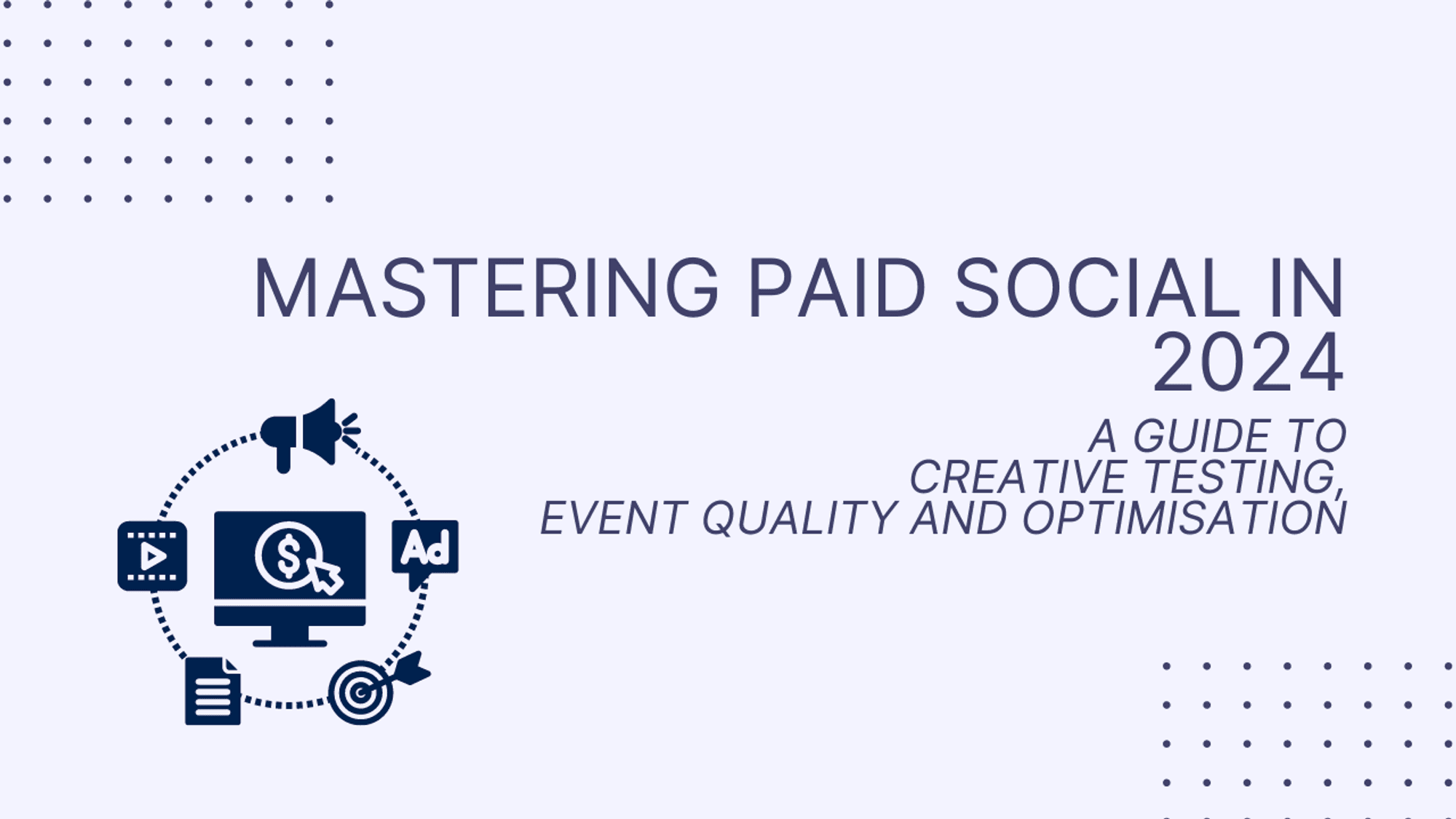Paid Social Blueprints
Mastering Paid Social in 2024: A Guide to Creative Testing, Event Quality, and Optimization
In 2024, winning at paid social means more than just setting up ads and hoping for the best. At Kitchn.io, we've spent years working with top paid social teams and have identified the three essentials for success: creative testing, event quality optimisation, and keeping your campaigns sharp with optimization and QA. These are the building blocks for standing out in the industry where everyone has the same tools at their disposal.
Introduction
In 2024, paid social success is no longer about just launching ads and waiting for results. In recent years it has advanced to a sophisticated landscape that demands a smarter, more strategic approach. We, at Kitchn.io, have been working closely with numerous paid social teams over the past years and we have identified three most important elements to master in 2024 if you want to succeed with paid social ads: creative testing, event quality, and optimization & QA.
We’ve identified them as the pillars of a winning strategy in a world where every marketer has access to similar tools. The difference lies in how you apply them. From designing compelling creatives that resonate with your audience to allocating your budget towards truly impactful actions and ensuring your campaigns perform flawlessly, these elements are crucial.
If you're aiming to rock your paid social strategy beyond the basics and leverage these core elements effectively, you're in the right place. Let's explore these game-changing strategies together, providing you with actionable insights to thrive in the competitive 2024 paid social landscape.
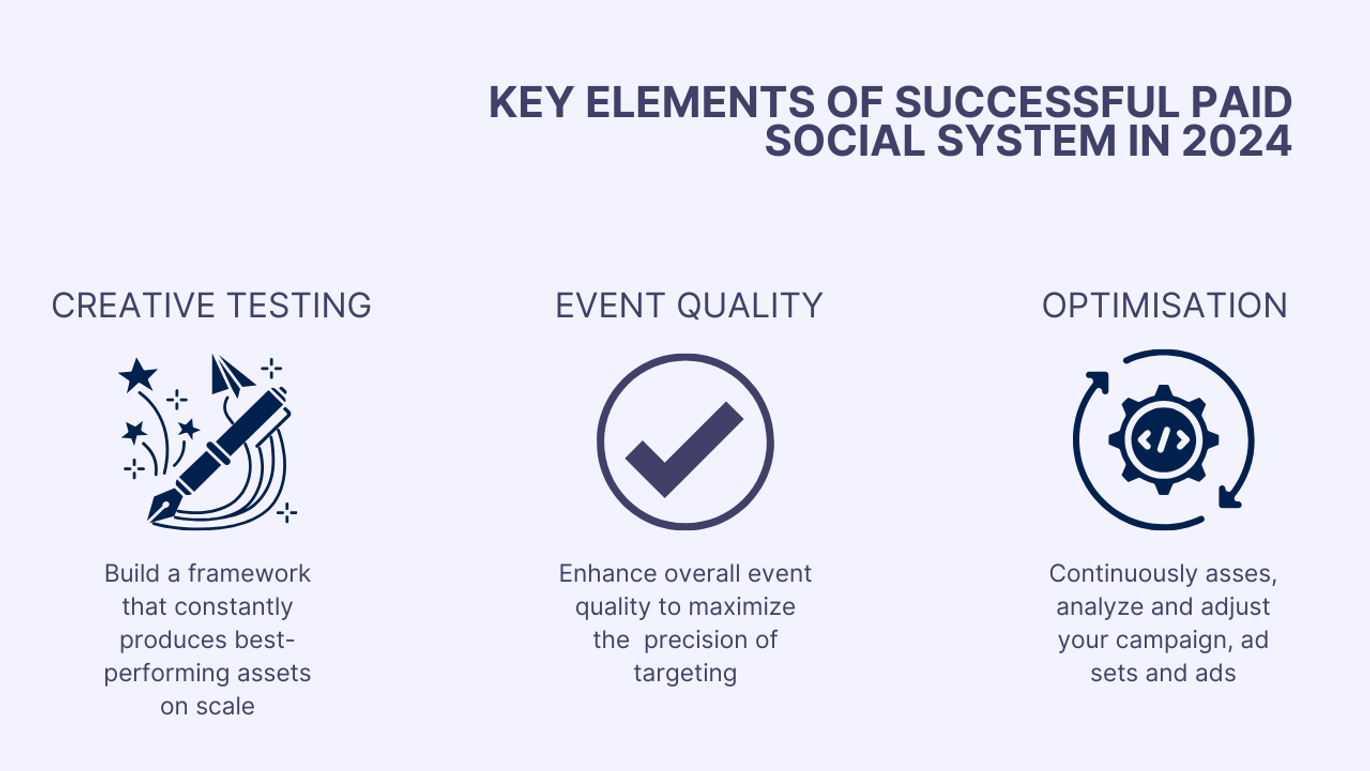
The Power of Creative Testing
In today's fast-paced digital marketing landscape, the success of paid social campaigns is built in the robustness of the systems behind them. Creative testing is a comprehensive system that ensures your marketing efforts remain effective and agile. Let's look into what makes a creative testing system not only functional but scalable and integral to your paid social success.
Establishing a Scalable Creative Testing System
A scalable creative testing system is foundational to staying competitive in the ever-evolving realm of paid social. It’s about building a framework that supports continuous improvement and adaptation. Here’s a structured approach to setting up such a system
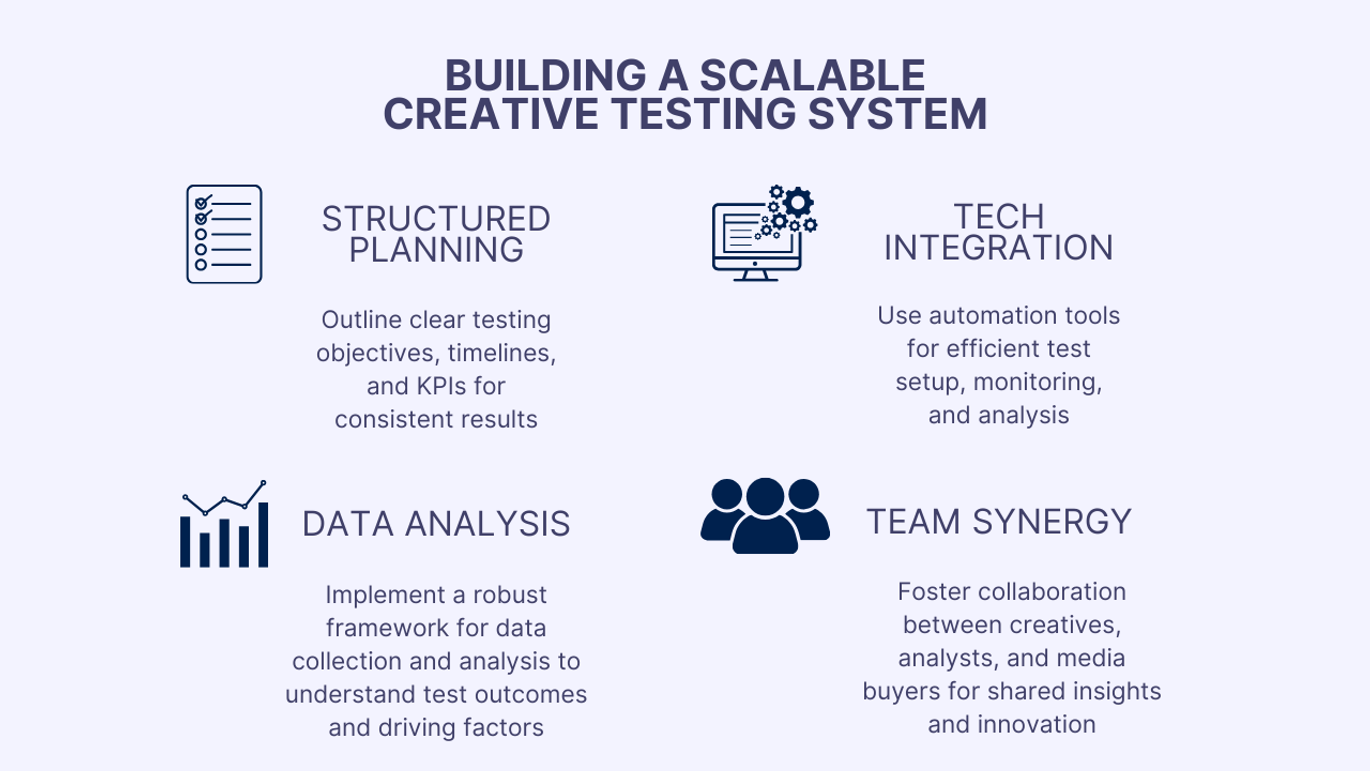
Systematic Planning
Begin by establishing a structured plan that outlines your testing objectives, timelines, and KPIs. This plan should be flexible enough to adapt to new insights and market trends but structured enough to provide consistent results over time.
Integration of Tools and Platforms
Utilize technology to streamline your creative testing process. Automation tools can help in setting up, monitoring, and analyzing tests, allowing for a more efficient use of resources. Choose platforms that offer detailed creative reportings and support integration of project management tools.
Data Collection and Analysis Framework
At the core of your system should be a robust framework for collecting and analyzing data. This involves not only tracking the direct outcomes of tests but also understanding the underlying factors driving those results.
Feedback Loops for Continuous Optimization
Create feedback loops that allow for the data and insights gained from testing to inform future creative strategies. This involves regular review sessions with your team to discuss what’s working, what isn’t, and how to iterate on creative concepts.
Cross-functional Collaboration
Ensure that your system encourages collaboration between creative teams, data analysts, and media buyers. Such collaboration ensures that insights are shared across departments, fostering a culture of continuous improvement and innovation.
Dedicated Responsible
For a creative testing system to truly be scalable, it requires dedicated oversight. This doesn’t mean one person doing all the work, but rather having a role within your team focused on overseeing the testing system as a whole.

This role involves:
- Coordinating between different departments to ensure alignment on objectives and methodologies.
- Overseeing the implementation of testing plans and sticking to timelines.
- Analyzing results and sharing insights with broader teams to guide future creative development.
Reflecting on Your Creative Testing System
Evaluating your current creative testing system is crucial. From time to time, try to answer these questions:
- Does it allow for scalability and flexibility?
- Does it constantly output best-performing assets?
- Is it integrated with the right tools and technologies to provide actionable insights?
Building a robust system is an investment in the future of your paid social campaigns and it will enable you to navigate the complexities of digital advertising with confidence and precision.
The power of creative testing lies not just in the ability to pick winning ads but in creating a system that drives growth, learning, and adaptation. By focusing on building and refining this system, you position your brand to thrive in the dynamic landscape of paid social media.
Optimizing Event Quality for Maximum Impact
Optimizing event quality in your paid social campaigns is like fine-tuning a high-performance engine, every adjustment needs to enhance overall efficiency and drive towards your ultimate goal: maximum impact.
This process involves a deep dive into the technical aspects of your tracking and data collection, focusing on metrics that directly influence your bottom line. Let's explore how to optimize these events, the role of first-party data, and the key metrics to guide your strategy.
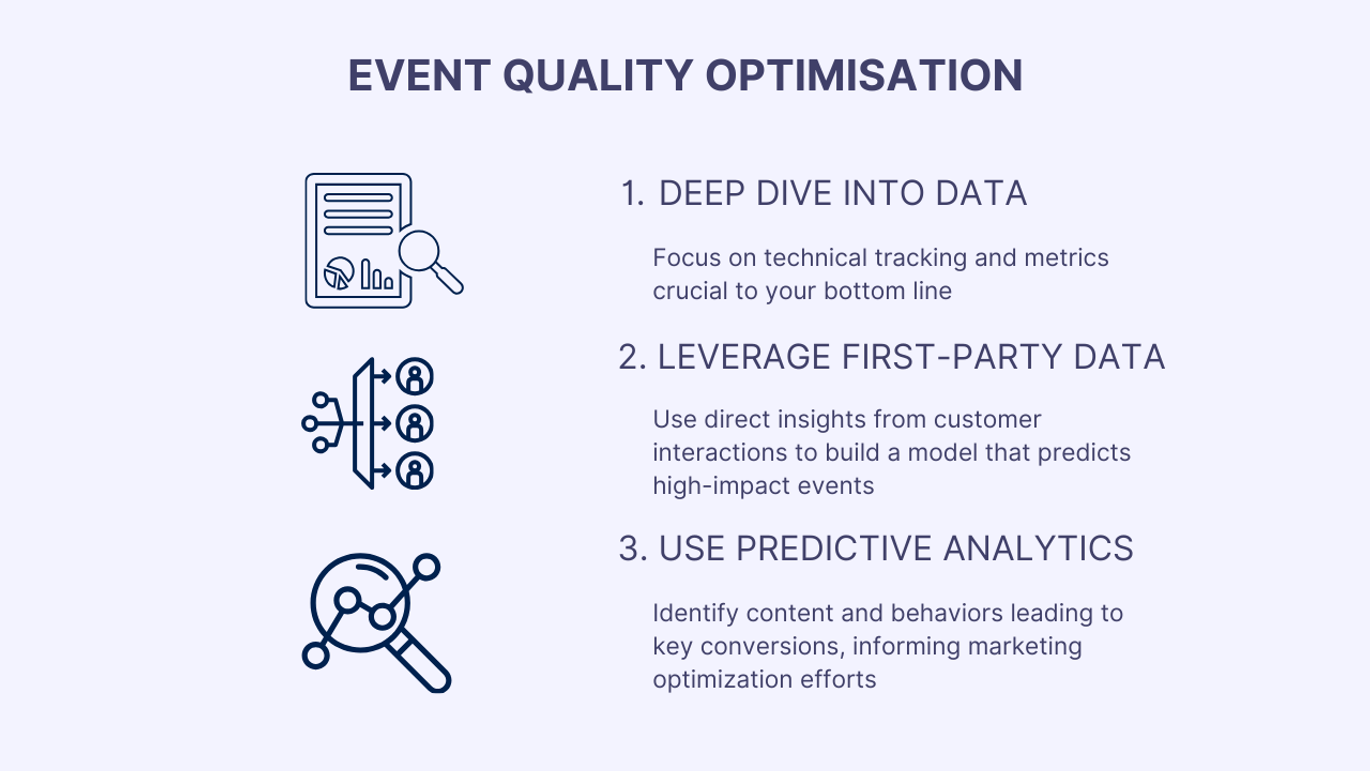
The Core of Event Quality Optimization
Event quality optimization is based on two critical concepts: incrementality and predicted CLV. Incrementality focuses on understanding the additional value generated by specific marketing actions, e.g. getting new customers, increasing your AOV, or improving your ROAS. It answers the question, "What real difference did this ad make?" Predicted CLV, on the other hand, estimates the total value a customer will bring to your business over their lifetime, guiding you to prioritize high-value customer segments.
Leveraging First-Party Data
First-party data is your most valuable asset in optimizing event quality. This data, collected directly from your interactions with customers, offers unmatched insights into their preferences, behaviors, and the customer journey. But instead of utilizing this data for more precise targeting, we suggest you try to build a model for better marketing optimisation events.
Instead of analyzing first-party data to identify customers who interact with a specific type of content to build new audiences, we suggest you try to find the data points that indicate when possible events that your best customer could do to use as an optimisation event.
Consider the power of predictive analytics. By analyzing your first-party data, you can identify not just the types of content that engage your best customers but also uncover patterns or behaviors that precede key conversion events. For example, you might find that customers who view certain product tutorials or engage in specific discussions on your platform are more likely to purchase the next interactions. These insights can then inform your optimization efforts, allowing you to tailor your marketing activities to encourage these behaviors.
Actionable Metrics for Optimization
To effectively optimize event quality, focus on the following metrics:
- Incrementality
Measure the direct impact of your ads by comparing the behavior of users exposed to the ad versus those who were not. - Predicted CLV
Calculate the predicted revenue a customer will generate during their relationship with your business. - Engagement Rate
Track how users interact with your content, identifying which types of engagement correlate with higher CLV. - Conversion Rate by Event
Analyze how different events contribute to conversions, focusing on those with the highest impact.
By concentrating on these metrics, you can refine your paid social campaigns to ensure that every element, from targeting to content, is aligned with driving meaningful, impactful interactions. This strategic approach allows you to allocate your resources more efficiently, investing in the areas that promise the greatest return on investment and fostering long-term customer relationships.
Campaign optimisation & QA
Here, we also want to highlight the critical role of optimization and QA, and how leveraging advanced systems and AI can transform this journey into a more predictable path to success.
Optimization
Optimization in paid social is a continuous cycle of assessment, adjustment, and analysis. It's about making data-driven decisions to enhance campaign performance in real-time. Let's break down this journey:
Assessment
The starting point involves a deep dive into current campaign metrics. You're looking at performance data, seeking out underperforming ads, and identifying high-potential opportunities.
Adjustment
Armed with insights, you tweak your campaigns. Maybe you shift budgets towards high-performing ads, or you test new creatives for ads that aren't hitting the mark.
Analysis
After adjustments, closely monitor the impact. How do the changes affect your KPIs? This step is crucial for learning what works and what doesn’t, guiding future strategies.
Quality Assurance
Quality Assurance is your safeguard against small errors that can significantly derail your campaigns. It's a detailed inspection of every campaign element before launch and ongoing monitoring thereafter. Consider these steps:
Pre-Launch Checks
Review every ad creative, links, headline, and CTAs for accuracy and alignment with campaign objectives. Ensure UTMs are correctly implemented to measure campaign performance accurately.
Ongoing Monitoring
Regularly check live campaigns for any issues. Are ads displaying as intended? Are landing pages loading correctly? This helps catch and correct problems before they impact your results.
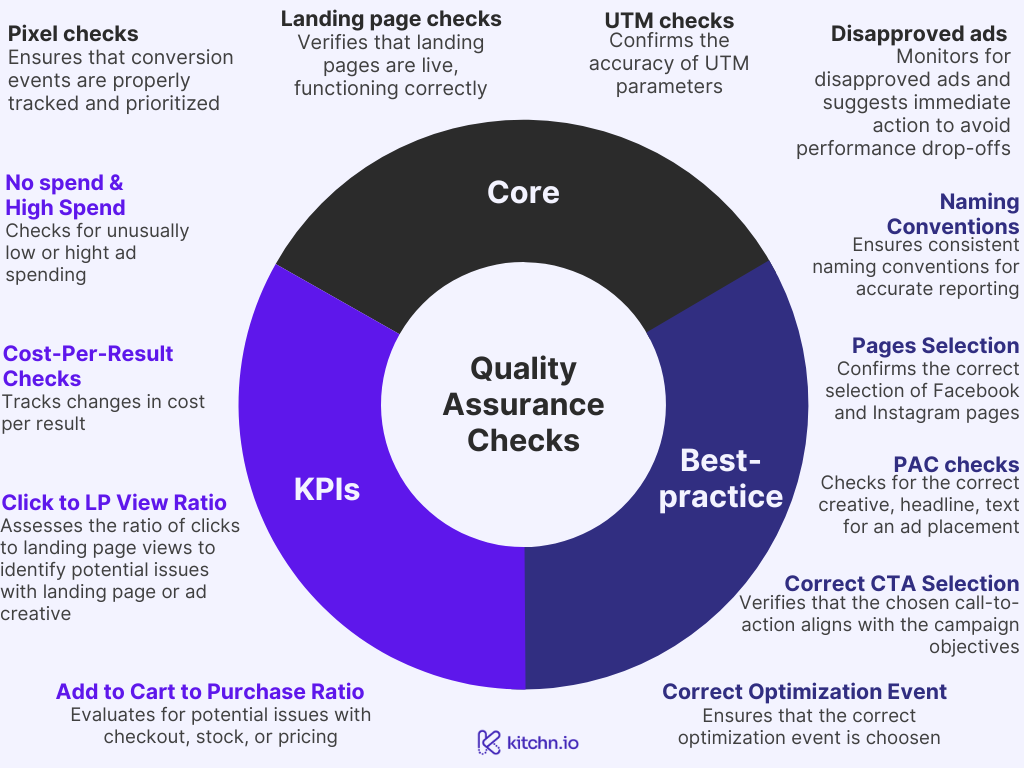
Embracing the Future: AI and Advanced Systems
The integration of AI and advanced systems offers a glimpse into the future of optimization and QA. These technologies can automate repetitive tasks, predict campaign outcomes, and even identify optimization opportunities you might miss. Imagine tech and AI-powered tools that:
- Predict the performance of different creatives, helping you select the best ones before spending a single ad dollar.
- Automatically adjust bids and budgets in real-time based on campaign performance, maximizing ROI.
- Conduct 24/7 QA checks, ensuring that issues are identified and addressed instantly, without human intervention.

While we strongly recommend automating the maximum of daily operations, we are aware that these systems need to be monitored and assessed before rolling them out completely.
Common mistakes include:
Over-Reliance on Automation
While AI and automation are powerful, they're not infallible. Always keep a human in the loop for strategic decisions and creative insights.
Neglecting the Basics
In the rush to embrace new technologies, don't overlook fundamental optimization and QA practices. Even the most advanced tools can't compensate for a lack of solid foundational work.
In conclusion, optimization and QA in paid social are not just tasks to be checked off. They're essential practices that require ongoing attention and refinement. By understanding the challenges, adopting a systematic approach, and leveraging the latest technologies, you can navigate the complexities of paid social with confidence.
Summary
As we wrap up our exploration into the future of paid social advertising, it's clear that the landscape is more dynamic and competitive than ever. To thrive in 2024, brands must embrace a holistic approach that goes beyond traditional tactics. The pillars of creative testing, event quality optimization, and rigorous QA and optimization are not just strategies but essential components of a comprehensive framework designed to bring your paid social campaigns to new heights.
Creative testing is your laboratory, where innovation meets analysis to produce ads that not only capture attention but resonate deeply with your audience. Event quality optimization, on the other hand, is your compass, guiding your campaigns towards the most impactful and meaningful interactions. And finally, optimization and QA act as the satefy net of your campaign's integrity, ensuring that every element performs at its best and aligns with your strategic goals.
Remember that the tools and technologies at our disposal are powerful allies. From AI-driven analytics to sophisticated automation platforms, these resources can amplify our efforts, streamline processes, and unlock new opportunities for growth and engagement. However, it's the strategic, thoughtful application of these tools that will ultimately define our success.
In closing, by focusing on building robust systems your team can navigate the complexities of the digital landscape with confidence.


